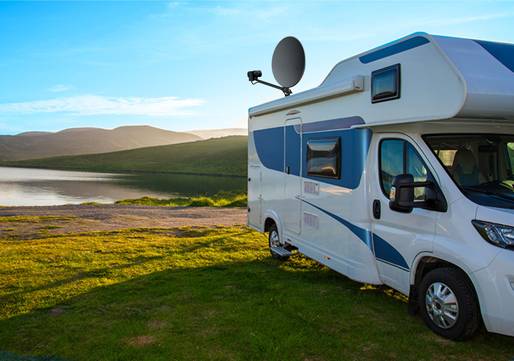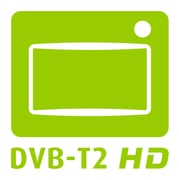Mobile TV » How to keep yourself entertained on the move
Updated: 06.11.2023 | Reading time: 7 minutes
This text is machine translated.
You don't need to miss out on the news, your favorite series, sports broadcasts and films when you're on the move. In the digital age, the technical options are many and varied. Via aerial and DVB-T, with a mobile satellite dish or online via the Internet: Depending on where and how you are on the move, a reception method with or without an Internet connection is recommended.
Handy portable devices bring information, entertainment and sport wherever you go: in the garden, in the motorhome and on the campsite, in the outdoor pool and even in the office if the kick-off of an important soccer match falls during working hours. It's just a matter of choosing the right technology. We have the right products for you for every application.
In our guide, you can find out how to receive mobile TV and what you need to do so.
Television is indispensable for many travelers. The camping TV travels in the motorhome or caravan and the tablet, smartphone or notebook serves as a TV receiver on the beach or at the quarry pond. In addition to classic satellite reception, you have a total of three reception options to choose from with DVB-T2 via antenna and Internet TV. Which one is best for you depends primarily on where you want to watch TV and how big your luggage can be.
Digital television and digital radio programs can be received via a satellite dish. The programs are broadcast via satellite signal, for example via the Astra satellite. For the TV experience, you need a portable satellite system that supports the current DVB-S2 standard. The abbreviation DVB-S stands for “Digital Video Broadcasting Satellite” and S2 denotes the newer standard for satellite broadcasting. DVB-H and DVB-SH, the combination of satellite and mobile radio transmission, have not been able to establish themselves on the market.
Here are the advantages of DVB-S2 at a glance:
✓ Television everywhere: TV reception even in remote areas
✓ Domestic channels can be received throughout Europe
✓ Channel diversity, thus large program selection
✓ Public broadcasters are also free of charge in HD quality
✓ Good picture quality, provided the satellite dish is correctly aligned
✓ Works independently of the mobile network
A mobile satellite system consists of a parabolic antenna or flat antenna with LNB module and mast mount or suction base, coaxial cable and possibly a tripod to set up the antenna. The position of the antenna is crucial as it determines the picture quality - obstacles such as trees and buildings can affect or even prevent reception.
You will also need a camping TV with DVB-S2 or a DVB-S2 receiver, which you connect to the mobile TV set. All this technology takes up a lot of space, which is why mobile satellite TV is particularly suitable for camping vacations. A camping satellite system contains everything you need for reception in a handy carrying case. Automatic systems align themselves precisely to the satellite for the TV program. So you can get started with a satellite finder without any fiddling.
The DVB-T2 HD standard is a space-saving and cost-effective solution for mobile television. Instead of a satellite system, a simple DVB-T2 antenna is often sufficient, as the appropriate receiver or tuner is already built into many televisions as standard.
Portable televisions with DVB-T2 are practical. If this is not the case with your device, you will need an external DVB-T2 receiver. Look out for a DVB-T2 receiver with a green logo: these devices can also receive private channels. Receivers without the green logo are limited to around 20 public service channels in this country.
DVB-T2 provides a good Full HD picture compared to its switched-off predecessor DVB-T. Because you do not need to set up a satellite dish, it can be set up quickly anywhere. Digital terrestrial television in Germany is offered by the provider Freenet. Around 70 channels can be received, here is an overview.
Here is an overview of the advantages of DVB-T2:
✓ Public broadcasters such as ARD, ZDF and the third channels can be received free of charge.
✓ Private TV channels such as RTL, Sat 1 and Prosieben are encrypted with DVB-T2. You pay around 7 euros per month for reception.
✓ Abroad, you can watch local programs in the national language.
✓ Transmission takes place via local broadcast antennas. German television can therefore not be received abroad.
✓ Works independently of the mobile network.
An inexpensive DVB-T2 stick for the USB port turns your laptop into a portable TV. Using the software, you can not only watch TV in full HD picture quality, but also record the current program. This means that the best Bundesliga goals or the latest episode of your favorite series automatically land on your notebook hard drive while you are out exploring.
Reception of public HD channels is free of charge. If you would also like to use private HD television, you will need a Freenet-certified USB stick. DVB-T2 sticks without the green logo only receive public channels. A stick with the green Freenet logo can also receive encrypted private channels.
Mobile television is not dependent on the classic transmission channels of satellite systems or terrestrial antennas. An Internet connection via mobile phone or WLAN is all you need for freedom when watching TV. Streaming makes reception outside your own four walls flexible: watch TV almost anywhere: in the allotment garden, by the pool or in public places.
With a smart TV, notebook, tablet or smartphone, you can watch live programs from TV channels as a stream. You can watch them either in your browser or via an app on mobile devices or smart TVs. The apps are usually free of charge. The device must be online for this. Internet access is included with cell phones. Notebooks, tablets and televisions with Wi-Fi surf via the smartphone's mobile data connection using the hotspot function or tethering. Alternatively, you can share the mobile data connection via a mobile Wi-Fi hotspot. Make sure you have a sufficiently large data flat rate.
The public broadcaster media libraries ARD, ZDF and the third channels are generally free of charge. However, charges may apply for the Internet connection.
Streaming technology is also available for retrofitting: streaming sticks or streaming boxes bring Internet TV to non-smart TVs at a later date. Even TV sets whose manufacturer no longer offers an update can be brought up to date in terms of streaming.
An important point when streaming TV content is the transmission speed of your Internet connection. To receive videos in good picture and sound quality, you need a fast connection with a continuous data stream. Both are not always available on mobile networks, campsite Wi-Fi and public hotspots.
For programs in standard definition (SD), a download speed of 2 Mbit/s or more is recommended. For programs in high-definition (HD) with 720p, 4 to 5 Mbit/s have proven to be the best. Programs in 1080p run smoothly from around 5 Mbit/s. If the Internet stream falters, the providers reduce the picture quality or dropouts occur.
Note: The Internet speed test Fast.com from Netflix can be used to check the actual downstream and upstream speed. You can find alternative test providers using the search term “speed test”.
The advantage of TV streaming via the Internet: You are not limited to the linear TV program and thus to TV consumption at the time of broadcast. The online connection also gives you access to the broadcasters' media libraries. The public broadcasters from ARD to ZDF and Arte offer their video-on-demand content free of charge. This means you benefit from more program variety and time independence. You are not tied to fixed broadcasting times and live streams, but can decide for yourself when you want to watch what you enjoy.
In the media libraries, you have the option of watching programs online after they have been broadcast. Conversely, TV productions are sometimes available in the media library before they are officially broadcast. You will not only find content from the main channels, but also from the third channels and from Phoenix, 3Sat, Kika, One, ARD-Alpha and so on. The channels ORF, DMAX and Servus-TV also offer free video access via streaming.
Do you have a subscription to the paid streaming media libraries of RTL (TV Now), Sat 1 / ProSieben (Joyn) or Sky? Then you can also access video content on the go. You can also use video flat rates from Netflix, Amazon Prime, Disney + and co. on the move.
A disadvantage: streaming films, series and sporting events in locations outside your home country may be restricted due to licensing conditions. Streaming services can use the IP address to determine whether your laptop or smartphone is located abroad. In this case, legally protected passages are excluded. However, news, documentaries and in-house productions can usually be streamed on the move without regional restrictions.
Note: If you are prepared to spend 10 euros or more for good TV entertainment on vacation, you can also take out a streaming subscription with Netflix & Co. for a limited period of one month. Then don't forget to cancel in good time. If you are planning a stay abroad, find out in advance whether so-called geoblocking may prevent you from using the streaming portal at your destination. A VPN connection may be able to help you access the streams anyway.
Network operators such as Deutsche Telekom, Vodafone, O2 and 1&1 offer television over IP (IPTV) as an option with their tariffs. There are TV apps for smartphones or tablets for reception on the move. If you already have a subscription for TV at home as a complete package from your Internet provider, it is worth taking a look at the small print to see how mobile use is regulated.
IPTV is also available on a subscription basis from free providers such as Waipu.tv and Zattoo. They bundle several channels into one streaming package. This makes it easy to zap from channel to channel on the move, almost like watching TV at home.

